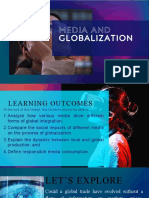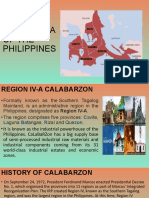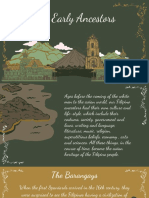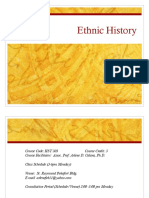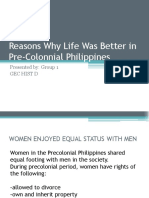0 ratings0% found this document useful (0 votes)
108 viewsBUGKALOT
BUGKALOT
Uploaded by
Jumemai MeannThe Bugkalot, also known as Ilongot, are an indigenous group living in northern Luzon, Philippines. They traditionally practiced swidden agriculture, growing crops like rice, sweet potatoes and vegetables. Hunting and fishing in rivers and forests also contributed to their economy. Politically, the Bugkalot lived in communities headed by a chief and assistants. Society was organized into kinship-based groups called bertan that provided members support. During Spanish colonization, most Bugkalot avoided colonizers by living in mountainous areas, and united with other groups at times to fight foreign invaders.
Copyright:
© All Rights Reserved
Available Formats
Download as DOCX, PDF, TXT or read online from Scribd
BUGKALOT
BUGKALOT
Uploaded by
Jumemai Meann0 ratings0% found this document useful (0 votes)
108 views3 pagesThe Bugkalot, also known as Ilongot, are an indigenous group living in northern Luzon, Philippines. They traditionally practiced swidden agriculture, growing crops like rice, sweet potatoes and vegetables. Hunting and fishing in rivers and forests also contributed to their economy. Politically, the Bugkalot lived in communities headed by a chief and assistants. Society was organized into kinship-based groups called bertan that provided members support. During Spanish colonization, most Bugkalot avoided colonizers by living in mountainous areas, and united with other groups at times to fight foreign invaders.
Original Description:
Copyright
© © All Rights Reserved
Available Formats
DOCX, PDF, TXT or read online from Scribd
Share this document
Did you find this document useful?
Is this content inappropriate?
The Bugkalot, also known as Ilongot, are an indigenous group living in northern Luzon, Philippines. They traditionally practiced swidden agriculture, growing crops like rice, sweet potatoes and vegetables. Hunting and fishing in rivers and forests also contributed to their economy. Politically, the Bugkalot lived in communities headed by a chief and assistants. Society was organized into kinship-based groups called bertan that provided members support. During Spanish colonization, most Bugkalot avoided colonizers by living in mountainous areas, and united with other groups at times to fight foreign invaders.
Copyright:
© All Rights Reserved
Available Formats
Download as DOCX, PDF, TXT or read online from Scribd
Download as docx, pdf, or txt
0 ratings0% found this document useful (0 votes)
108 views3 pagesBUGKALOT
BUGKALOT
Uploaded by
Jumemai MeannThe Bugkalot, also known as Ilongot, are an indigenous group living in northern Luzon, Philippines. They traditionally practiced swidden agriculture, growing crops like rice, sweet potatoes and vegetables. Hunting and fishing in rivers and forests also contributed to their economy. Politically, the Bugkalot lived in communities headed by a chief and assistants. Society was organized into kinship-based groups called bertan that provided members support. During Spanish colonization, most Bugkalot avoided colonizers by living in mountainous areas, and united with other groups at times to fight foreign invaders.
Copyright:
© All Rights Reserved
Available Formats
Download as DOCX, PDF, TXT or read online from Scribd
Download as docx, pdf, or txt
You are on page 1of 3
BUGKALOT
The Bugkalot appear in most ethnograohic studies as “Ilongot”, and
thus are genereally called such by outsiders. However, BUgkalot, also
spelled Bugkalut, is what they call themselves. The ety mology of the term
is unknown, but Ilungot, which is another self- designation , means :from the
fores.” “Ilongot” or “Ilungot” comes from the prefix I, denoting “people”,
and gongot o longot, “forst”; thus the word means “people of the forest.”
Ngot or Ngut also suggest fierceness. A Spanish version is “Egongot.”
“Ilongot” has come to connote such negative images as “savage,”
“treacherous,” and “ferocious,” largely as a result of Spanish and American
colonialist bias. However, atleast two people’s organizations in QUirino
carry the name “Ilongot.”
Lowland converts, particularly the Usinay, refer to the Bugkalt as
Ibalao or Ivalao. Other terms refer to Ilongot subgroups: “Abaka” refers to
the COnwap river settlers, “Italon,” to the northern waters of Cagayan river
settlers, and “Igongut,” to the Tabayon river settlers.
The BUgalot language, aka Ilongot, Bugkalut, BUkalot, and Lingotes,
is spoken by more than 50,000 people, mostly in Quirino Province, eastern
Nueva Vizcaya province, south Isabela province, and around the northern
part of Cagayan River.
History
Spanish Colonization barely penetrated th BUgkalot domain. Instead
some natives were lured to the lowland missions. These converts, like the
Bugkalot of Baler, were exempted from tribute. Protected by mountains
and forests, most BUgkalot were able to repel foreign intrusions. In 1591 and
1592, a number of Spaniards were killed by the Bugkalot in the expeditions
led by Don Luis Perez Dasmarinas. Hence, Spaniards policy on the Bugkalot
became belligerent; nonetheless, all their subsequent punitive expeditions
failed. At times different ethnolinguistic groups united against the common
foreign enemy. The Isinay town of Burubur in southern Nueva Vizcaya was
liberated by the combined Isinay- Gaddang- Bugkalot forces soon after it
was occupied by th Spaniards in the early 1700s.
Economy
Swidden agriculture is traditionally the Bugkalot’s primary means of
food production. Plants are cut down, left to dry, then burned during the
penguma (preparation of the kaingin) from January to March. Unlike many
groups engaging in swidden cultivation, The Ilongot do not cut down large
trees. Instead, they practiced tengder (pollarding), a process in which
branches of large trees are cut off to let sunshine into the newly created
field.
Felled branches are sun-dried, then burned. The clearing of the field’s
debris id done by the women when the rainy season begins. The BUgkalot
plant sugarcane, coconuts, rice, sweet potatoes, cucumbers, squash, and
other vegetables. They gather shellfish from the streams and roots, and
palms, fruits honey, and beeswax from the forests. Food is prepared by
boiling, roasting, or smoking, and preserved by somking, salting, and
sunning, such as with the pindang (sun-dried meat).
Fishing and hnting are current economic activities as important as
farming. They fish in the river with nets and traps, using poisonous berries as
bait, for instance; they use bow and arrow when they dive to shoot larger
fish. Their catch includes kadezap (cockroach of the river). Kanit (worm of
the river), iget (eel), beyek (goby fish; Tag, biya), alaken (frogs), tak-kang
(crabs), nuto (snails), guddong (carp), tilapia, and kulanip (shrimps).
Political System
An alipian, a community of several families, is headed by a
kapanawan, who is assisted by a macotay. A kapanawan was chosen as
the chief for his head taking prowess and his health, measured in terms of
property. In 1929, a 30-year0old who had taken 42 meals was the most
famous kapanawan among the Bugkalot. Today, leadership is based on
ability and age, and at the highest level remains absolute and valid until
death. When the chief dies, he is replaced by his assistant, and a new
assistant is selected.
The ceremonial powers of the nigudu (shaman) can sometimes
extend to sociopolitical matters. The beganganat or begenget
(community elders) settle conflicts that may arise between the
beganganat and the nigudu. BUgkalot common law prohibits murder,
adultery, deceit, theft, work on each fifth day, wives’ disobedience of their
husbands, and nonpayment of debts. Crimes are usually punished by fines
and beatings. The families of offenders are partly accountable for the
offenses; thus, are involved int the settlemen of both civil and criminal
crimes.
Social Oragnization and Practices
The Bugkalot belong to social groups of expanding size and scope
from families, households, and local clusters, to their largest social unit, the
bertan. The bertan clusteris is a kinship system defined by the members’
descent from a common ancestor whose place of residence is recognized
by members to be their common origin, such as “downstream, in the
lowlands, on an island, near a mountain” (Rolando, M. 1980, 9-10)
Going by thir origin stories, one bertan sees itself as unrelated to
another if they have no common ancestor. On the other hand, the bertan
is more a social feature that promotes unity through common concerns
instead of disconnectedness. Thus, members of a bertan, though living
separeately in various settlements, can reasonably expect loyalty or
assistance from one another. The bugkalot population consists of 13 bertan,
the Belansi, Benabe, Payupay, Rumyad, Abeka , Taang, Aymuyu, Dekran,
Tamsi, Pugu, Kabinengan, SInebran, and Be’nad. The Americans during
their military campaign in north Luzon pitted the bertan against one
another as part of the divide- and- rule strategy.
You might also like
- GED103 ReviewerDocument10 pagesGED103 Reviewerleigh jannah ramosNo ratings yet
- 2018-11-01 Bake From Scratch PDFDocument116 pages2018-11-01 Bake From Scratch PDFLia Vágvölgyi100% (3)
- IPs REPORTDocument11 pagesIPs REPORTMae Dela PenaNo ratings yet
- Indigenous Peoples' SpiritualityDocument13 pagesIndigenous Peoples' SpiritualityJonardo Jonel DalimagNo ratings yet
- In Search of Self Determination PDFDocument18 pagesIn Search of Self Determination PDFJor DanNo ratings yet
- Cordillera Administrative Region: Philippine Indigenous CommunitiesDocument13 pagesCordillera Administrative Region: Philippine Indigenous CommunitiesKirsten FernandoNo ratings yet
- Bodong: MST Review 18 No. 2 (2016) : 63-75Document32 pagesBodong: MST Review 18 No. 2 (2016) : 63-75roljan paclebNo ratings yet
- Local and Global Communication in Multicultural SettingDocument15 pagesLocal and Global Communication in Multicultural SettingMariane EspiñoNo ratings yet
- Indegenus Practices Group 2Document35 pagesIndegenus Practices Group 2Alaysa Nicole TangonanNo ratings yet
- Different Dances in The PhilippinesDocument5 pagesDifferent Dances in The PhilippinesDiane VideñaNo ratings yet
- Final ReflectionDocument2 pagesFinal Reflectionapi-341077378No ratings yet
- Lesson 10: Annotation of Antonio Morga's Sucesos de Las Islas FilipinasDocument1 pageLesson 10: Annotation of Antonio Morga's Sucesos de Las Islas FilipinasGreen CastleNo ratings yet
- RPH Mindanao in Pre Colonial PeriodDocument6 pagesRPH Mindanao in Pre Colonial PeriodKristine Marie Delos ReyesNo ratings yet
- Chapter 1Document18 pagesChapter 1Steven ReyesNo ratings yet
- BugkalotDocument2 pagesBugkalotMaricris FlorendoNo ratings yet
- Part of Unhistorical Data DiscussionDocument3 pagesPart of Unhistorical Data DiscussionFrederick John75% (4)
- The Igorot Struggle For Independence - William Henry ScottDocument10 pagesThe Igorot Struggle For Independence - William Henry ScottSinedpak DufamNo ratings yet
- Position Paper On The Lumad As Victims of Development Aggression in Southern MindanaoDocument10 pagesPosition Paper On The Lumad As Victims of Development Aggression in Southern MindanaoAlyssa Molina100% (1)
- Letter To The Women of Malolos: ISO 9001:2015 TÜV-R 01 100 1934918Document3 pagesLetter To The Women of Malolos: ISO 9001:2015 TÜV-R 01 100 1934918Jochebed MirandaNo ratings yet
- IVATANDocument3 pagesIVATANDannica Ignacio AbsalonNo ratings yet
- History 3 Thought PaperDocument25 pagesHistory 3 Thought PaperCarmela Faith DacerNo ratings yet
- The HoaxDocument14 pagesThe HoaxXardNo ratings yet
- Media & Telecoms Landscape Guide - PhilippinesDocument218 pagesMedia & Telecoms Landscape Guide - PhilippinesJenine QuiambaoNo ratings yet
- Evolution of Philippine ConstitutionDocument25 pagesEvolution of Philippine ConstitutionKim Kyun SiNo ratings yet
- VocabularyDocument14 pagesVocabularyMary Rose ArguellesNo ratings yet
- Ungkaurimoteh 140706210614 Phpapp02Document19 pagesUngkaurimoteh 140706210614 Phpapp02bigbang100% (1)
- Customs of The TagalogsDocument25 pagesCustoms of The TagalogsMary Joyce YuNo ratings yet
- Titled in Some Books As "The Maid" and "Un Coquette": Basic InformationDocument3 pagesTitled in Some Books As "The Maid" and "Un Coquette": Basic InformationJolina InverseNo ratings yet
- Language in The Philippines An OverviewDocument14 pagesLanguage in The Philippines An Overviewerikakimperez7No ratings yet
- English Today: Regional DiversityDocument4 pagesEnglish Today: Regional DiversitySall LeoNo ratings yet
- Mansaka Tribe: A Group of Mansaka Tribeswomen in Their Formal AttireDocument6 pagesMansaka Tribe: A Group of Mansaka Tribeswomen in Their Formal Attirejs cyberzoneNo ratings yet
- In Gay Paris (1885-86) : CHAPTER 7: Paris To BerlinDocument5 pagesIn Gay Paris (1885-86) : CHAPTER 7: Paris To BerlinCyrus SegismundoNo ratings yet
- Group2 - Media and Globalization (Revised)Document30 pagesGroup2 - Media and Globalization (Revised)Jaren Paul Yadao-LozadaNo ratings yet
- I Am A FilipinoDocument11 pagesI Am A FilipinoJemima FalinchaoNo ratings yet
- Customs of The Tagalogs - Group 1Document2 pagesCustoms of The Tagalogs - Group 1Yna CunanNo ratings yet
- Indigenous People Written ReportDocument7 pagesIndigenous People Written ReportJoel Batucan Ngojo Jr.No ratings yet
- VISAYASDocument4 pagesVISAYASpatricia navasNo ratings yet
- The Phonetic Structures of Kalanguya (University of The Philippines, Diliman Undergraduate Thesis, 2010)Document11 pagesThe Phonetic Structures of Kalanguya (University of The Philippines, Diliman Undergraduate Thesis, 2010)Paul Julian Santiago100% (1)
- Region 4 A CalabarzonDocument20 pagesRegion 4 A CalabarzonAloes BreciaNo ratings yet
- Individual Thought Paper 1 Instructions Q22020-2021Document4 pagesIndividual Thought Paper 1 Instructions Q22020-2021Kei Ef SiNo ratings yet
- Simple Vintage Illustration History Ancient Times Report PresentationDocument53 pagesSimple Vintage Illustration History Ancient Times Report Presentationあい アリソンNo ratings yet
- Activity 1 Tenant Grievances and Rizal's PetitionDocument4 pagesActivity 1 Tenant Grievances and Rizal's PetitionAsher AgunosNo ratings yet
- New Era University: de Ramos, Jonalyn G. MW (8:30-10:00 Am) Prof. Lilibeth Cruz Module 11 AssignmentDocument4 pagesNew Era University: de Ramos, Jonalyn G. MW (8:30-10:00 Am) Prof. Lilibeth Cruz Module 11 AssignmentJonalyn G. De RamosNo ratings yet
- Ethnic History OF THE PHILIPPINESDocument28 pagesEthnic History OF THE PHILIPPINESLeyn MarallagNo ratings yet
- The Institution of The JuramentadoDocument5 pagesThe Institution of The JuramentadoHarvie Kenneth MAGPULONGNo ratings yet
- Indigenous People in Northern Philippines: Igorot: Prepared By: Aina M. BalangDocument42 pagesIndigenous People in Northern Philippines: Igorot: Prepared By: Aina M. BalangAnalyn FielNo ratings yet
- Inaugural Address of Dr. Francisco B. BenitezDocument6 pagesInaugural Address of Dr. Francisco B. BenitezpwunewsNo ratings yet
- From Deen BenguetDocument17 pagesFrom Deen BenguetInnah Agito-RamosNo ratings yet
- History of RizalDocument24 pagesHistory of Rizalyeooon liangcoNo ratings yet
- Reasons Why Life Was Better in Pre Colonnial PhilippinesDocument11 pagesReasons Why Life Was Better in Pre Colonnial PhilippinesMichael Brian Torres100% (1)
- Customs of The Tagalogs: Kaspil2 V24 Module2 Group2 Cho - Espina.Idiesca - Macapugay.Salita - SeeDocument45 pagesCustoms of The Tagalogs: Kaspil2 V24 Module2 Group2 Cho - Espina.Idiesca - Macapugay.Salita - SeeARYATNo ratings yet
- Filipinos Under The Spanish ColonizationDocument1 pageFilipinos Under The Spanish ColonizationIsza Marie N. SocorinNo ratings yet
- Character of Noli Me TangereDocument39 pagesCharacter of Noli Me TangereHAKUNA MATATANo ratings yet
- What Is RA 8371Document5 pagesWhat Is RA 8371John Lester L. EsmaNo ratings yet
- Chapter 2Document44 pagesChapter 2Abby Umali-HernandezNo ratings yet
- BatanesDocument4 pagesBatanesMark Anthony Faune100% (2)
- Argumentative Essay Draft 2Document2 pagesArgumentative Essay Draft 2api-286311815100% (2)
- Indigenous Ethnolinguistic Groups in VisayasDocument101 pagesIndigenous Ethnolinguistic Groups in VisayasHaiko MitshiNo ratings yet
- History of BaguioDocument2 pagesHistory of BaguioCaryll DagupenNo ratings yet
- What Is Global Migration? What Are The Types of Global Migration?Document3 pagesWhat Is Global Migration? What Are The Types of Global Migration?Rye MiiiNo ratings yet
- Tindahan PricingDocument3 pagesTindahan PricingMaribelle PragadosNo ratings yet
- Soal Am Bahasa InggrisDocument22 pagesSoal Am Bahasa InggrisReski zunaid sawaliNo ratings yet
- Prepare Sandwiches Lo1Document89 pagesPrepare Sandwiches Lo1Jacky Ilaban100% (1)
- Matcha Fraisier - Fraisier Cu Pudra de Ceai VerdeDocument15 pagesMatcha Fraisier - Fraisier Cu Pudra de Ceai Verdeneagu.adinaNo ratings yet
- Easy Tapas Cookbook A Collection of Spanish Tapas Recipes For Real Latin AppetizersDocument66 pagesEasy Tapas Cookbook A Collection of Spanish Tapas Recipes For Real Latin AppetizerstilabrisaNo ratings yet
- BHM First Semester SyllabusDocument11 pagesBHM First Semester SyllabusMadrid RealNo ratings yet
- Heart Healthy Diet - TambahanDocument31 pagesHeart Healthy Diet - TambahanAileen GhifariNo ratings yet
- Coding Product ChatgptDocument9 pagesCoding Product ChatgptTI 1B 33 MarifahNo ratings yet
- Big X Tkj-Keperawatan, Jumat, 25-09-20-Task 1-2-AninditaDocument9 pagesBig X Tkj-Keperawatan, Jumat, 25-09-20-Task 1-2-AninditaisabelaNo ratings yet
- PC Armenia CookbookDocument617 pagesPC Armenia CookbookA G100% (1)
- I. Learning Competency With Code LO 2. Prepare and Cook Egg Dishes (MELC 2)Document9 pagesI. Learning Competency With Code LO 2. Prepare and Cook Egg Dishes (MELC 2)Claire BeeNo ratings yet
- Food Technology and Design Specimen PaperDocument16 pagesFood Technology and Design Specimen Paperaisha kay ChimbalangaNo ratings yet
- Ekadasi Recipes: Srila A.C. Bhaktivedanta Swami Prabhupada's Standard For EkadasiDocument23 pagesEkadasi Recipes: Srila A.C. Bhaktivedanta Swami Prabhupada's Standard For EkadasiSue100% (1)
- Tiger 3 Story CardsDocument112 pagesTiger 3 Story Cardswszystkiegoangielskiego.mmNo ratings yet
- Processing and Medicinal Uses of Cardamom and Ginger - A ReviewDocument6 pagesProcessing and Medicinal Uses of Cardamom and Ginger - A Reviewdilip trivediNo ratings yet
- Passive Voice Simple Present Tense Esl Exercises Worksheet PDFDocument2 pagesPassive Voice Simple Present Tense Esl Exercises Worksheet PDFprincerafa100% (2)
- Pennington Pizza-Grill MenuDocument6 pagesPennington Pizza-Grill Menurobua86100% (1)
- Keto For BeginnersDocument39 pagesKeto For BeginnersGobnait MurphyNo ratings yet
- The Waiters Handbook 4e - Chapter 3 Food Service Equipment-2Document21 pagesThe Waiters Handbook 4e - Chapter 3 Food Service Equipment-2varapornNo ratings yet
- Time Worded QuestionsDocument4 pagesTime Worded QuestionsMe-nickyNeikaNo ratings yet
- Transformation From Paddy To Flaked RiceDocument9 pagesTransformation From Paddy To Flaked RiceSanjay BhoirNo ratings yet
- Ropa MimiDocument15 pagesRopa MimiHường Thu ĐoànNo ratings yet
- Whyalla Hotel PRIMO MENU Nov2020 1.12mbDocument4 pagesWhyalla Hotel PRIMO MENU Nov2020 1.12mbrohanschulzeNo ratings yet
- Community Public Health Nursing Practice Health For Families and Populations 5th Edition Maurer Test BankDocument36 pagesCommunity Public Health Nursing Practice Health For Families and Populations 5th Edition Maurer Test Banksejanttrend.hebh7100% (31)
- 식품공전 해설서 PDFDocument325 pages식품공전 해설서 PDFgilka buenoNo ratings yet
- Educational Concern: Dainoden, Saada M. Yousof, Anida MDocument8 pagesEducational Concern: Dainoden, Saada M. Yousof, Anida MR Hornilla ArcegaNo ratings yet
- LAS - TLE 9 Cookery-4th Qtr-Wek 5Document2 pagesLAS - TLE 9 Cookery-4th Qtr-Wek 5Cerelina GalelaNo ratings yet
- Siemens: Service ManualDocument36 pagesSiemens: Service ManualHAITHM MURSHEDNo ratings yet
- Berg Stile100 User ManualDocument56 pagesBerg Stile100 User ManualBerginnovationsNo ratings yet

































